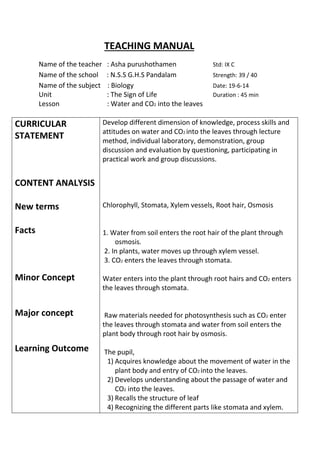
Lesson template
- 1. TEACHING MANUAL Name of the teacher : Asha purushothamen Std: IX C Name of the school : N.S.S G.H.S Pandalam Strength: 39 / 40 Name of the subject : Biology Date: 19-6-14 Unit : The Sign of Life Duration : 45 min Lesson : Water and CO2 into the leaves CURRICULAR STATEMENT CONTENT ANALYSIS New terms Facts Minor Concept Major concept Learning Outcome Develop different dimension of knowledge, process skills and attitudes on water and CO2 into the leaves through lecture method, individual laboratory, demonstration, group discussion and evaluation by questioning, participating in practical work and group discussions. Chlorophyll, Stomata, Xylem vessels, Root hair, Osmosis 1. Water from soil enters the root hair of the plant through osmosis. 2. In plants, water moves up through xylem vessel. 3. CO2 enters the leaves through stomata. Water enters into the plant through root hairs and CO2 enters the leaves through stomata. Raw materials needed for photosynthesis such as CO2 enter the leaves through stomata and water from soil enters the plant body through root hair by osmosis. The pupil, 1) Acquires knowledge about the movement of water in the plant body and entry of CO2 into the leaves. 2) Develops understanding about the passage of water and CO2 into the leaves. 3) Recalls the structure of leaf 4) Recognizing the different parts like stomata and xylem.
- 2. Pre-Requisite Teaching Learning Resource 5) Compares the transport of water and CO2 into the leaves. Plants prepare their food by means of photosynthesis using CO2 and water. 1) Chart showing the transport of water and CO2 into the leaves 2) Pepperomium plant, ink, water and beaker 3) Text book of XIth Std by SCERT, Kerala 4) Hand book CLASS ROOM INTERACTION PROCEDURE EXPECTED PUPIL RESPONSE INTRODUCTION Teacher make rapport with the students by asking questions related to contextual situation. 1. The process of photosynthesis takes place in which part of plant? 2. Which are the raw materials needed for photosynthesis? 3. How CO2 and water enters into leaves? Activity 1 Teachers show pepperomium plant with root hairs placed in a bottle with coloured solution and ask students to observe the movement of solution into the plant body. {CB} Osmosis xylem vessel Discussions Point Water enters into the plant body through root hairs by osmosis. Water moves up through the xylem vessels. Activity 2 Teachers show a chart on the structure of stomata in leaves and entry of Co2 into it and ask student to observe the chart? Pupil interacts with the teacher Leaves CO2, water, sunlight Pupil will not be able to explain Students observe the experiment. Student observe the chart
- 3. Discussions Point Co2 from the atmosphere enter into the leaves through a specialized structure called stomata. Activity 3 Teacher show an uncompleted flow chart on the text and ask the students to read the passage of Co2 and water into the leaves and ask students to complete the chart. Atmosphere Co2 leaf }CB Soil Water Students complete the chart
- 4. Discussions Point AtmosphereCo2Stomata leaf Soil Water Root hair Xylem Water from the soil enters the root hairs through osmosis. Then it moves up through the xylem vessels and enters the leaves. At the same time Co2 from the atmosphere enters the leaves through stomata. CHALKBOARD SUMMARY BIOLOGY Water & CO2 into leaves Std: IX C Strength: 39 / 40 Stomata – bean shaped – guard cell Date: 19-6-14 Atmosphere – CO2 stomata Leaf Soil Water Root hair Xylem Review 1. Explain how water enters into leaves? 2. Explain how Co2 enters the leaves? Follow up Draw a flow chart on the entry of Co2 and water into the leaves.